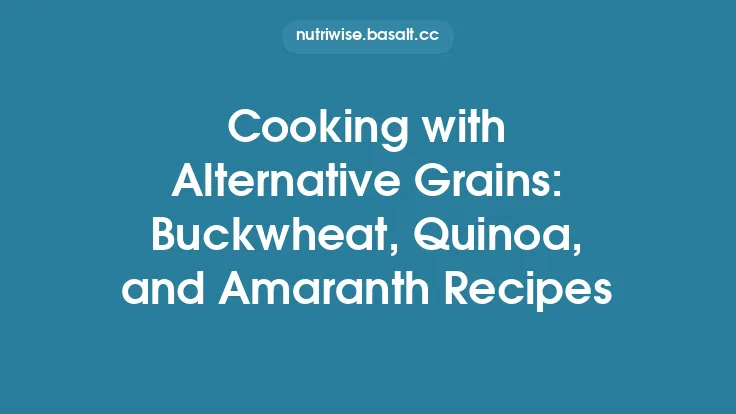Whole grains have been a staple in human diets for millennia, yet modern eating patterns often favor refined products that strip away the very components that make grains beneficial for cardiovascular health and longevity. By re‑integrating whole grains into everyday cooking, you can tap into a dense package of fiber, micronutrients, and bioactive compounds that collectively support a resilient heart and a longer, healthier life. This article explores the science behind whole grains, practical ways to select, store, and prepare them, and how their unique nutritional profile translates into tangible heart‑protective effects.
Understanding What Makes a Grain “Whole”
A grain is considered whole when it retains all three of its anatomical parts:
- Bran – the outer layer rich in dietary fiber, B‑vitamins (especially thiamine, riboflavin, and niacin), and antioxidants such as phenolic acids.
- Germ – the embryo of the seed, packed with essential fatty acids, vitamin E, magnesium, and phytosterols.
- Endosperm – the starchy interior that supplies carbohydrates and protein.
When grains are milled into refined flour, the bran and germ are removed, leaving primarily the endosperm. This process dramatically reduces fiber content, diminishes micronutrient density, and eliminates many phytochemicals that have been linked to reduced inflammation and improved endothelial function.
The Cardiovascular Benefits of Whole‑Grain Consumption
1. Fiber and Lipid Regulation
Soluble fiber, abundant in oats, barley, and rye, forms a viscous gel in the gastrointestinal tract that binds bile acids. The body must then synthesize new bile acids from circulating cholesterol, effectively lowering low‑density lipoprotein (LDL) concentrations. Epidemiological studies consistently show that each 7‑gram increase in daily soluble fiber intake can reduce LDL cholesterol by approximately 5 %.
2. Glycemic Control and Insulin Sensitivity
Whole grains have a lower glycemic index (GI) than their refined counterparts because the intact bran slows carbohydrate digestion and glucose absorption. Stable post‑prandial glucose excursions reduce the risk of insulin resistance, a known precursor to atherosclerosis. Long‑term adherence to a diet rich in low‑GI whole grains has been associated with a 15‑20 % reduction in the incidence of type 2 diabetes, indirectly protecting the heart.
3. Antioxidant and Anti‑Inflammatory Phytochemicals
Phenolic acids (e.g., ferulic acid), flavonoids, and lignans present in the bran layer scavenge reactive oxygen species and modulate inflammatory pathways. Chronic low‑grade inflammation drives endothelial dysfunction and plaque formation; thus, regular intake of these compounds contributes to vascular health.
4. Micronutrients Supporting Vascular Tone
Magnesium, potassium, and calcium—found in appreciable amounts in whole‑grain quinoa, amaranth, and buckwheat—play pivotal roles in regulating blood pressure. Magnesium, for instance, acts as a natural calcium antagonist, promoting vasodilation and reducing arterial stiffness.
5. Gut Microbiome Modulation
The fermentable fiber in whole grains serves as a prebiotic substrate for beneficial gut bacteria, leading to the production of short‑chain fatty acids (SCFAs) such as butyrate. SCFAs have been shown to improve lipid metabolism, lower systemic inflammation, and even influence blood pressure regulation through signaling pathways involving G‑protein‑coupled receptors.
Selecting the Right Whole Grains for Your Kitchen
| Grain | Notable Nutrient Highlights | Typical Culinary Uses |
|---|---|---|
| Oats (rolled, steel‑cut) | β‑glucan soluble fiber, avenanthramides (antioxidants) | Breakfast porridges, baked goods, savory pilafs |
| Barley (hulled, pearled) | High soluble fiber, selenium | Soups, stews, grain salads |
| Brown Rice (short, medium, long) | B‑vitamins, manganese | Side dishes, stir‑fries, rice bowls |
| Quinoa (white, red, black) | Complete protein, magnesium, iron | Salads, grain bowls, stuffed vegetables |
| Farro (spelt, emmer) | Protein, zinc, B‑vitamins | Risottos, grain salads, soups |
| Millet | Phosphorus, niacin | Polenta‑style porridges, baked goods |
| Buckwheat (groats, flour) | Rutin (flavonoid), magnesium | Pancakes, soba noodles, porridge |
| Rye (whole‑grain flour, kernels) | Soluble fiber, lignans | Bread, crispbreads, hearty soups |
| Amaranth | Lysine (essential amino acid), calcium | Porridge, thickening agent for soups |
| Sorghum (whole kernels, flour) | Antioxidant phenolics, iron | Pilafs, gluten‑free baking |
When shopping, prioritize products labeled “100 % whole grain” or “whole‑grain” without qualifiers such as “multigrain” (which may contain refined components). Inspect the ingredient list; the first ingredient should be the whole grain itself.
Proper Storage to Preserve Nutrient Integrity
Whole grains contain natural oils, especially in the germ, which are prone to oxidation. To maximize shelf life and retain antioxidant capacity:
- Cool, Dark, Dry Environment: Store grains in airtight containers (glass jars with tight‑fitting lids or food‑grade Mylar bags) in a pantry away from heat and light.
- Refrigeration/Freezing for Long‑Term Storage: For bulk purchases, keep grains in the refrigerator (up to 6 months) or freezer (up to 12 months). This is especially important for high‑oil grains like quinoa, amaranth, and brown rice.
- Avoid Moisture: Ensure containers are completely dry before sealing. Moisture can promote mold growth and degrade fiber quality.
Cooking Techniques that Preserve Heart‑Healthy Qualities
1. Rinsing and Soaking
Rinsing removes surface dust and residual phytic acid, which can bind minerals. Soaking (30 minutes to 12 hours, depending on grain hardness) reduces cooking time, improves texture, and further diminishes antinutrients. Discard the soaking water and replace with fresh liquid for cooking.
2. Optimal Water‑to‑Grain Ratios
Accurate ratios prevent over‑hydration, which can leach soluble fiber into the cooking water. General guidelines:
- Oats (steel‑cut): 1 cup oats : 3 cups water
- Barley (hulled): 1 cup barley : 3 cups water
- Brown Rice: 1 cup rice : 2 ½ cups water
- Quinoa: 1 cup quinoa : 2 cups water
Adjust based on desired firmness; a “chewy” texture retains more resistant starch, beneficial for glycemic control.
3. Gentle Simmering vs. Rapid Boiling
A gentle simmer allows starch granules to gelatinize gradually, preserving the structural integrity of the bran and preventing the loss of soluble fiber. Rapid boiling can cause the outer layers to break apart, releasing nutrients into the cooking liquid.
4. One‑Pot “Pilaf” Method
Sautéing the grain briefly in a small amount of oil (or water for a fat‑free version) before adding liquid creates a toasted flavor and a slight protective coating that reduces nutrient leaching. This technique also enhances the Maillard reaction, contributing to deeper taste without added sodium or fats.
5. Steaming for Delicate Grains
Steaming whole‑grain farro, millet, or buckwheat preserves volatile phytochemicals that might be lost in boiling water. Use a steamer basket over simmering water, covering tightly, and steam until grains are tender (typically 15‑25 minutes).
6. Incorporating Whole Grains into Fermented Foods
Fermentation (e.g., sourdough made with whole‑grain flour) can increase bioavailability of minerals by degrading phytic acid and introducing probiotic bacteria that produce additional SCFAs. This synergistic effect further supports cardiovascular health.
Enhancing Bioavailability Without Compromising Heart Health
- Acidic Additions: A splash of lemon juice or a modest amount of vinegar at the end of cooking can lower the pH, improving mineral absorption (especially iron and zinc) from the grain matrix.
- Pairing with Vitamin C‑Rich Produce: While not a focus of this article, it is worth noting that adding tomatoes, bell peppers, or citrus to grain‑based dishes can boost non‑heme iron uptake without adding sodium or unhealthy fats.
- Avoid Over‑Processing: Grinding whole grains into ultra‑fine flour increases surface area, accelerating oxidation of lipids in the germ. Opt for coarser whole‑grain flours or retain the grain’s natural texture.
Whole Grains in a Longevity‑Focused Diet
Research on populations with exceptional longevity—such as the “Blue Zones” of Okinawa, Sardinia, and Loma Linda—consistently highlights whole grains as a dietary cornerstone. The mechanisms linking whole grains to extended lifespan include:
- Reduced Oxidative Stress: Antioxidants in the bran mitigate cellular damage over time.
- Improved Metabolic Flexibility: The combination of fiber, protein, and complex carbohydrates supports efficient energy utilization and prevents metabolic syndrome.
- Maintenance of Vascular Elasticity: Magnesium and potassium help preserve arterial compliance, reducing the workload on the heart.
- Gut‑Brain Axis Support: SCFAs produced by grain‑derived fiber influence neuroinflammation, potentially lowering the risk of cognitive decline—a factor intertwined with overall longevity.
Sample Whole‑Grain‑Centric Recipes (Heart‑Friendly Foundations)
Below are three versatile preparations that showcase whole grains while adhering to heart‑healthy principles. Each recipe emphasizes minimal added sodium, balanced macronutrients, and preservation of grain integrity.
1. Barley‑And‑Root Vegetable Pilaf
*Ingredients*
- 1 cup hulled barley, rinsed and soaked 1 hour
- 3 cups low‑sodium vegetable broth (optional: replace half with water)
- 1 cup diced carrots
- 1 cup diced parsnips
- ½ cup diced celery
- 1 tbsp olive‑oil‑free cooking spray (or a few drops of water for sauté)
- Fresh thyme, rosemary, and black pepper to taste
*Method*
- Heat a heavy‑bottomed pot; lightly spray and add carrots, parsnips, celery. Sauté 3 minutes until fragrant.
- Add drained barley, stir to coat with the vegetable aromatics.
- Pour broth/water mixture, bring to a gentle simmer, cover, and cook 35‑40 minutes until barley is tender and liquid absorbed.
- Fluff with a fork, garnish with fresh herbs, and serve as a side or base for a protein‑rich main.
2. Quinoa‑And‑Leafy‑Green Breakfast Bowl
*Ingredients*
- ½ cup quinoa, rinsed
- 1 cup water
- 1 cup lightly steamed kale, chopped
- ¼ cup diced apple (optional for natural sweetness)
- 1 tbsp ground flaxseed (omega‑3 source, but not the focus)
- A pinch of cinnamon
*Method*
- Combine quinoa and water in a saucepan; bring to boil, reduce heat, cover, simmer 15 minutes.
- Remove from heat, let stand 5 minutes, then fluff.
- Stir in steamed kale, apple, flaxseed, and cinnamon. Serve warm.
3. Whole‑Wheat Sourdough Flatbread (Fermented Grain)
*Ingredients*
- 2 cups whole‑wheat flour (unbleached)
- ½ cup active sourdough starter (100 % whole‑grain)
- ¾ cup water, lukewarm
- 1 tsp honey (optional, for starter activation)
*Method*
- Mix flour, starter, water, and honey until a shaggy dough forms.
- Knead 5‑7 minutes until smooth; cover and let rise 3‑4 hours at room temperature.
- Preheat a cast‑iron skillet; divide dough into 4 portions, flatten each to ¼‑inch thickness.
- Cook each flatbread 2‑3 minutes per side until golden spots appear. Use as a base for vegetable toppings or as a side.
Monitoring Progress and Adjusting Intake
While whole grains are universally beneficial, individual responses can vary based on gut microbiota composition, existing metabolic conditions, and overall dietary patterns. Consider the following practical steps:
- Track Fiber Intake: Aim for 25‑30 g of total dietary fiber per day, with at least 10 g from whole grains. Use a food diary or nutrition app to ensure consistency.
- Observe Gastrointestinal Tolerance: A sudden increase in fiber can cause bloating. Gradually introduce new grains and maintain adequate hydration (≈30 ml water per gram of fiber) to support smooth transit.
- Periodic Lipid Panels: Regular blood tests (every 6‑12 months) can reveal improvements in LDL, HDL, and triglyceride levels, providing objective feedback on the impact of whole‑grain consumption.
- Adjust Portion Sizes Based on Energy Needs: While whole grains are nutrient‑dense, they also contribute calories. Align portion sizes with activity level to avoid unintended weight gain, which can counteract cardiovascular benefits.
Concluding Thoughts
Integrating whole grains into daily cooking is a straightforward, evidence‑based strategy to fortify heart health and promote longevity. By understanding the distinct components of whole grains, selecting high‑quality varieties, storing them properly, and employing cooking methods that preserve their fiber, micronutrients, and phytochemicals, you can create meals that nourish the cardiovascular system from the inside out. Over time, these culinary choices compound, reducing cholesterol, stabilizing blood sugar, supporting vascular elasticity, and fostering a gut environment that further protects the heart. Embrace whole grains not merely as a side dish, but as a foundational element of a resilient, heart‑friendly kitchen.





